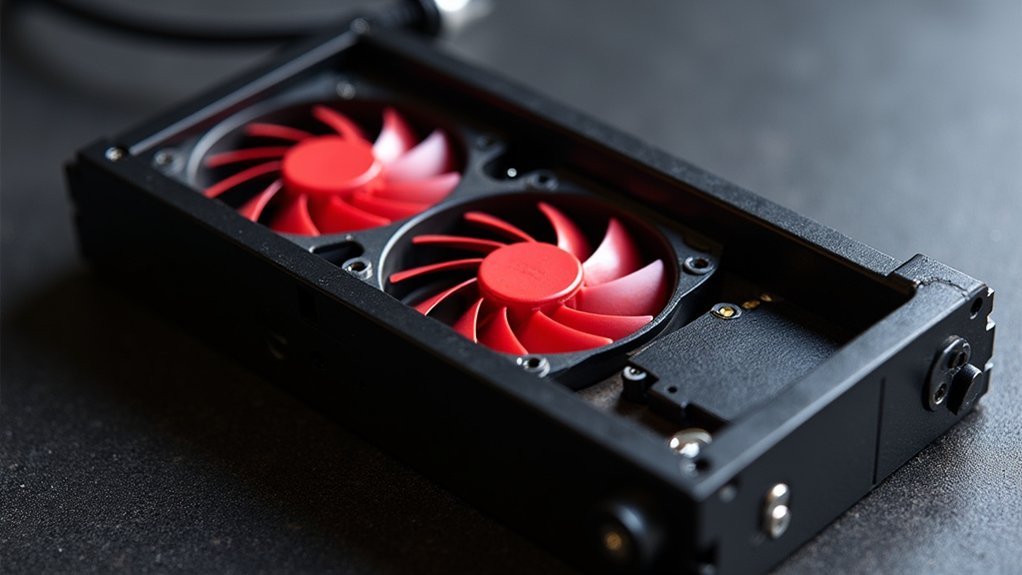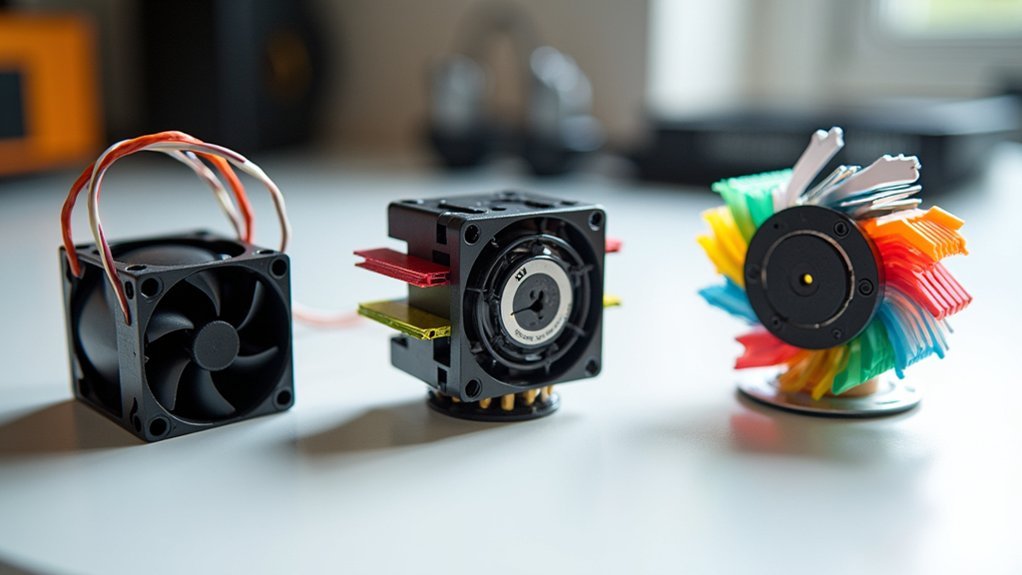You can upgrade your hotend cooling fan using three effective methods: direct stock replacement with a Noctua NF-A4x10 FLX for simple noise reduction, silent fan upgrade with housing modifications that add air intake vents for enhanced cooling, or complete shroud installation with dual fans for maximum performance. Each method requires careful attention to polarity when transferring JST connectors and verifying your printer’s voltage compatibility. These upgrades greatly reduce noise while improving print quality and component longevity through better thermal management.
Silent Fan Upgrade With Housing Modification

When you’re tired of your 3D printer’s noisy hotend fan disrupting your workspace, upgrading to a Noctua NF-A4x10 FLX 12V fan offers the ideal solution for achieving whisper-quiet operation without sacrificing cooling performance.
This new fan replacement greatly reduces noise levels by up to 20 decibels compared to stock cooling fans.
You’ll need to modify your hotend housing by adding cut-out air intake vents to maximize airflow efficiency.
These modifications guarantee proper cooling while maintaining peak print quality.
Before installation, use your soldering iron to attach JST connectors to the fan wires, checking polarity carefully to prevent electrical damage.
The combination of silent fan technology and improved housing ventilation creates an enhanced hotend cooling system that transforms your printing environment into a notably quieter workspace.
Direct Stock Fan Replacement Method
If you prefer a straightforward approach without housing modifications, direct stock fan replacement offers the simplest path to quieter 3D printing. This method involves swapping your original hotend cooling fan with a quieter alternative like the Noctua NF-A4x10 FLX 12V. You’ll maintain existing mounting points while upgrading performance.
The process requires careful attention to electrical connections and proper installation:
Proper electrical connections and meticulous installation are critical for successful hotend fan replacement and optimal printer performance.
- Remove the original hotend fan and re-use the connectors by carefully desoldering and transferring them to new fans.
- Verify power supply compatibility ensuring voltage matches your printer’s 12V or 24V system.
- Secure installation using original screws and nuts to mount the replacement fan.
- Test part cooling functionality by heating the hotend above 60°C to confirm automatic activation.
Complete Shroud and Dual Fan Configuration

While direct replacement works well for basic upgrades, complete shroud and dual fan configurations take hotend cooling performance to the next level.
You’ll achieve greatly improved airflow by installing two fans in a properly designed shroud with cut-out air intakes. Make sure you use heat inserts or M4 nuts for secure mounting and vibration reduction.
When upgrading to different fans like Noctua models, verify airflow direction matches your duct design. The dual setup would still require new connectors for proper electrical connection.
Position one side to draw air while the other pushes, creating ideal circulation around your hotend. This configuration reduces noise levels while providing superior cooling from multiple angles, preventing overheating and enhancing overall print quality.
Frequently Asked Questions
Does a Flex Fan Cool Better Than a Clutch Fan?
You’ll find flex fans cool better than clutch fans because they operate continuously, move more air at low speeds, and can reduce engine temperatures by 10-15°F more effectively.
Is a Hotend Fan Necessary?
Yes, you’ll absolutely need a hotend fan for successful 3D printing. Without it, you’ll experience heat creep, filament jams, and poor print quality as temperatures won’t stay consistent.
What Are the Three Types of Engine Cooling Fans?
You’ll find three main engine cooling fan types: mechanical fans that’re belt-driven by the crankshaft, electric fans powered by your vehicle’s electrical system, and hybrid fans combining both technologies.
How Do I Choose a Cooling Fan for My Control Panel?
You’ll want to check voltage compatibility with your printer model, select low-noise options like Noctua fans, guarantee proper dimensions for mounting, and balance airflow performance with noise levels.





Leave a Reply